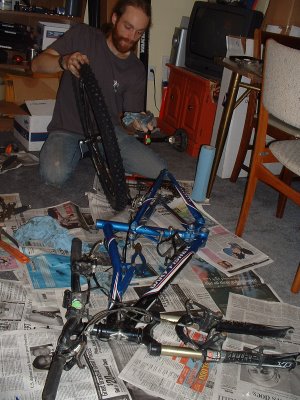 All this time I've been desk surfing at work - busy, busy election season, you know - Geoff's been overhauling bikes like it's his job. He spent the past two on my mountain bike. Since yesterday he removed just about every moving part, greased it up, installed a new chainring and chain (my last one was stretched two inches from its original length), massively degreased the drivetrain, re-adjusted both the derailleurs and pumped up the rear shock. I don't even knowing what else he did to it when I wasn't looking. I, um, cleaned the cassette. Yeah, I've been working pretty hard.
All this time I've been desk surfing at work - busy, busy election season, you know - Geoff's been overhauling bikes like it's his job. He spent the past two on my mountain bike. Since yesterday he removed just about every moving part, greased it up, installed a new chainring and chain (my last one was stretched two inches from its original length), massively degreased the drivetrain, re-adjusted both the derailleurs and pumped up the rear shock. I don't even knowing what else he did to it when I wasn't looking. I, um, cleaned the cassette. Yeah, I've been working pretty hard.I haven't had a chance to ride it yet, but I feel confident in making the statement that this is pretty much the best Gary Fisher women's specific Sugar 3+ mountain bike of unspecified year ... ever. I think the green sticker on the handlebars is what really puts it on top. That sticker has survived more rain and mud and abuse than even the headset could handle. You know that's quality craftmanship, right there. Thanks, Carlos :-).
As this all came down, and as my mountain bike became temporarily unrideable, I had a little time to reflect on how emotionally attached I can become to certain inanimate objects. It's interesting, because I'm not exactly one of those people who goes nuts about "stuff." I make a terrible consumer. I never buy anything new. I wear all my outdoor gear into the ground and then grind it further into the dirt just for good measure. Then, when it finally comes time to toss it away, I never give it a second thought.
But every once in a while, something clicks. I think about a happy memory or a harrowing adventure, and I remember the object and the way it carried me though. It's rare, but therein lies the beginning of an attachment that runs deep, a vulnerable yet sincere emotion so close to human that when I say I "love" my Sugar, I'll almost mean it. I actually feel this way about my car. People give me a lot of crap for this - it's a 1996 Geo Prism, 145,000 miles, lucky if it's still worth more than $1,000. But I've had it for six years. It's taken me across dozens of states and most of the Canadian provinces. It's been driven over boulders and 100-mile-long dirt roads. It's been bashed into a parked car and pummelled by a downed sycamore tree. I'm convinced that when it does cease to run, I'll cease to own a car. But not until then.
Now, I look at Sugar in his dozens of pieces, and I think that I'll probably just continue to fix him up, add new parts, do what I can to keep him on the trail until the frame disintegrates (or I do.) I know that's not what's actually going to happen. Mountain bike relationships aren't meant to last forever. But it's romantic to pretend it could.







